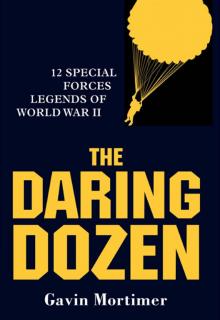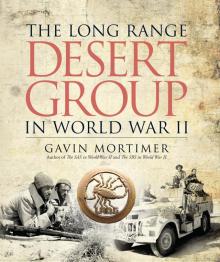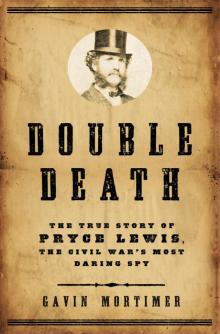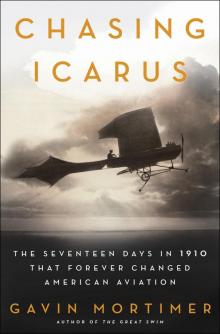- Home
- Gavin Mortimer
Chasing Icarus Page 3
Chasing Icarus Read online
Page 3
But where Frank Marshall had failed to sufficiently promote the Claude Grahame-White brand, Sydney McDonald succeeded. Throughout the summer of 1910, the flier “scooped the pool,” as the British press were wont to say, accepting a $10,000 retainer for a series of exhibition flights in the north of England and winning $5,000 in a distance race in Wolverhampton.
As for Grahame-White’s third passion, that required the least effort. He could handle the female of the species far more deftly than he could an airplane, and women were prone to go weak-kneed at the sight of his athletic six-foot frame in the same way men were the moment they spied a flying machine.
He was disarmingly handsome, with a strong mouth, full lips, and deep brown eyes, and he would tuck his shock of dark hair under his cap, then turn the cap back to front. To women, it was another sign of Grahame-White’s rakishness; to those of his own sex it was yet more evidence of his insufferable vanity. The man was preposterous, they seethed, more in love with himself than anyone else. But in truth it wasn’t so much Grahame-White’s undeniable ego that grated on many men, but his perfection. Tall, beautiful, debonair, witty, courageous, rich, talented . . . he damned well had the lot.
At an aviation meet in June at Brooklands racetrack, twenty miles southwest of London, Grahame-White had been at the center of an unseemly squabble between two women who should have known better. For many years he had been on friendly terms with Pauline Chase (to him she was Polly, to her he was Claudie), a twenty-five-year-old American actress with golden hair, a pert nose, and a gleam in her blue eyes that suggested that perhaps she wasn’t quite the ingenue she appeared to be at first glance. She certainly knew what she wanted from a man, and it wasn’t a good heart or a worthy talent. “I’ve no time to waste on duffers with no position or money,” she had once famously told a reporter.
Chase had made her stage debut at age thirteen at the Casino Theater in New York, but apart from a colorful role as the Pink Pajama Girl in the racy Broadway show Liberty Belles, her early career was uneventful. Then in 1904 she was offered the part of First Twin in a new production about to open in London called Peter Pan; audiences were captivated by the play and its writer, James Barrie, was similarly entranced by Chase. She became his goddaughter when she was christened in 1906, and the same year Chase was elevated to the title role in Peter Pan. The Times of London considered that she brought a certain “delicate grace” to the part, and the Chicago Tribune found her “distractingly pretty.” Her name became synonymous with the little boy who wouldn’t grow up, and Grahame-White had lost count of the number of times he had sat in the front row of the Duke of York’s Theater scowling at Captain Hook.
On the June day in question, Grahame-White had promised Chase over lunch that he would take her for a spin in his Farman biplane later that afternoon.* Chase was thrilled. Her self-promotion was as ardent as Grahame-White’s, and she could picture the following day’s headlines: PETER PAN FLIES FOR REAL.
Unfortunately for Chase, when she arrived at Brooklands she was confronted by an indomitable English aristocrat, Lady Abdy, a “rather massive but handsome woman . . . who had taken a violent fancy to Mr. Grahame-White.” So violent was her fancy that Lady Abdy had bid £150 ($750) for the chance to fly with her very own Eros in a lunchtime charity auction held in Grahame-White’s absence. As he helped Chase up into the seat of his biplane, Lady Abdy thundered across the racetrack and “with an evident dislike of his attractive companion, angrily and abusively asserted her right to the first flight.” Grahame-White tried to explain to her ladyship that he needed first to go for a quick test flight, but she was having none of it. Did he really expect her, Lady Abdy, to play second fiddle to a common American actress? Fearing the Englishwoman might physically assault Chase, Grahame-White “gave in and took-off in a foul mood, with Lady Abdy triumphantly ensconced behind him.” Within seconds of taking off, however, the airplane’s engine stalled (probably unable to withstand the weight of the “massive but handsome” passenger), and Grahame-White had to crash-land in the sewage farm that bordered the racetrack. Both walked away without a scratch, much to the relief of Pauline Chase, who, with a perfumed glove over her nose, inquired ever so solicitously after the well-being of Lady Abdy.
Grahame-White’s charismatic appeal in Europe hadn’t gone unnoticed by the promoters of American aviation meetings, and neither had his fondness for Pauline Chase. That she was coming to New York to star in a Broadway production of Our Miss Gibbs at the Knickerbocker was doubtless used by the promoters as another reason why Grahame-White should accept an invitation to tour the United States. He sailed from En-gland at the end of August, a few days after he had been paid $50,000 for putting on a show in Blackpool on the northwest coast of England. Hundreds of his fans, mostly female, were quayside to wave him off, and only after several minutes did they quiet enough for him to say a few words to the press corps. “I hope to give a good account of myself in the various competitions,” Grahame-White began, at which point a young woman pushed past the reporters and thrust into his hands a good-luck sprig of white heather, asking nothing more in return than a kiss. “I am confident,” he continued, “of being able to maintain the reputation of Great Britain, which I regard as being in advance of America with reference to aerial navigation.”
When Grahame-White arrived in a rainy Boston on September 1, dozens of American reporters were there to greet him. “Fine flying weather for ducks,” he joked, adding that he was eager to get into action at the Boston Meet in two days’ time. Ever the consummate showman, Grahame-White patiently answered every question with a smile, and he was particularly attentive to the female correspondents who had braved the weather. His diligence paid off handsomely. The Boston Post’s sob sister wrote that Grahame-White “is possessed of a fine athletic figure and is the best set-up man in the whole flock of birdmen who have entered the Meet. Unlike the silent, mysterious Americans, who seem to be out of their element on the ground, Grahame-White is thoroughly at home with his two feet everywhere.” Another reporter, Phoebe Dwight (this was her nom de plume, her real name being Eleanor Ladd), had a warning for the men of Boston: “If you want your lady-loves’ hearts true to you, it’s hardly safe to amuse them by taking them out to the aviation Meet. For before you know it these hearts may be fluttering along at the tail of an airplane, wherein sits a daring and spectacular young man who has won the title of the matinee idol of the aviation field, Claude Grahame-White.”
Dwight’s prophecy came to pass, and by the end of the Boston Meet women were falling over themselves to fly with the Englishman. For Grahame-White it was the opportunity to combine several of his passions, and he instructed Sydney McDonald to charge $500 for a five-minute trip. Dozens of women were happy to pay this enormous sum, from Katharine Reid, “a spinsterish schoolmarm who arrived accoutered for the air in outsize motoring goggles, legs swathed mummywise in burlap,” to Marie Campbell, who, in the opinion of the New York Herald, was “an uncommonly attractive young woman . . . with comely features.”
Of even more interest was the sight of Miss Eleonora Sears being helped up into the seat behind Grahame-White. Instantly, the American newspapers identified the twenty-eight-year-old brunette as Grahame-White’s feminine equivalent. Sears was a Boston socialite, the great-great-granddaughter of Thomas Jefferson and the daughter of a father regarded as one of the wealthiest men in America. She had many other attributes: good looks, charm, talent, and an insatiable energy. The previous spring she had walked 108 miles in two days from Burlingame to Del Monte in California, and barely a day passed without the papers reporting on her latest athletic feat. As for potential suitors, they couldn’t keep up. In the same week that Grahame-White arrived in Boston, the Chicago Daily Tribune reported that Sears, “the society girl who plays polo, golf, tennis, rides to the hounds, shoots, hunts and fences, with a vim and a dash that have won her worldwide reputation, has two rivals for her hand.”
One, the paper continued, was the arctic hunter Paul J. Raine
y, who had traipsed “almost to the north pole to get her some bear pelts,” and the other was Harold Vanderbilt, who had first come across Miss Sears in the fall of 1909 when, as a Harvard law student, he unsuccessfully defended her in a Boston court on charges of overspeeding her automobile. Vanderbilt was not a natural athlete, commented the Tribune, but so strong was his ardor that he “had to play tennis in the broiling sun, golf till the soles of his feet cracked and try out occasionally a bucking broncho [sic], when he would have much preferred reclining upon a silken divan.”
But with Rainey now in the snowy wastes in search of more pelts and Vanderbilt touring Europe, Sears saw nothing wrong in broadening her horizons. Of course, she had to put the opposition in the shade, and her flight time of eleven minutes and thirty seconds was a record for a female passenger in America. “It was perfectly heavenly!” she cried to reporters afterward. “Just the finest thing I ever enjoyed . . . Really, honest and truly, I wasn’t scared a bit. Mr. Grahame-White just makes you feel that it is all coming out all right. I knew from the time we left the ground until we landed that I wasn’t in the least danger when he was driving.” Miss Sears autographed a wing of the plane, as was the habit among Grahame-White’s admirers, then handed over the check for $500 with a promise that it wouldn’t be the last.
One person who hadn’t been persuaded to take a trip with Grahame-White—even a free one—was President Taft. He had been a fascinated spectator at the Boston Meet on September 9 but declined the invitation to fly with a quip about his 250-pound size. TAFT INTEREST PLEASES WHITE was the headline in the Boston Globe, leaving one to wonder if the Englishman hadn’t now usurped the president in national importance. John “Honey Fitz” Fitzgerald, the mayor of Boston (and the grandfather of John F. Kennedy), accepted an offer and later praised Grahame-White’s “perfect control of his machine.” The three men got on famously, underlining the Englishman’s magnetic personality. Princes, presidents, pressmen, Peter Pan—they all appeared to be under the spell of Grahame-White.
But the nine-day Boston Meet had a serious side, and Grahame-White never let himself be distracted by a pretty face or a big name. He was in America to win, and at Boston he did so spectacularly, taking four first prizes, including in the blue-ribbon event, the thirty-three-mile race from the airfield to Boston Light* and back. That earned him $10,000, bringing his total earnings during the meet to $22,500. At a time when office clerks earned on average $5 a week, store assistants $7, and railway conductors $10, it was a fantastic sum. Boston threw a dinner in his honor, and a starstruck Mayor Fitzgerald handed over the check along with a silver loving cup on which was inscribed FROM BOSTON FRIENDS, IN ADMIRATION OF HIS SKILL AND SPORTSMANSHIP AS AN AVIATOR.
Grahame-White was now arguably the most famous man in America, and the size of the offers he received reflected his enormous pulling power. He accepted a $50,000 contract to fly at the Brockton Fair in Massachusetts in early October (but turned down a series of speaking engagements with the Keith vaudeville agency at $2,000 a throw), then left for New York with his manager to discuss with the event’s promoters the possibility of entering the International Aviation Cup race. Of course, he would make sure he found time to take in a Broadway show, perhaps Our Miss Gibbs at the Knickerbocker Theater.
A month later, on the morning of Saturday, October 15, Grahame-White had banked his Brockton check for $50,000 and was a member of the three-man British team that would contest the International Aviation Cup against America and France at Long Island’s Belmont Park racecourse.† He intended to leave Washington, D.C., in a couple of days, once he’d fulfilled his engagements, among them an appearance as the guest of honor at a party thrown by Mr. and Mrs. John Barry Ryan at the Cosmos Club that evening.
The six weeks he had thus far spent in the United States had been an unalloyed success. Aside from the money he had made and the women he had wooed, Grahame-White had enjoyed the American attitude to life. The Americans’ hard-nosed approach to business and their straight-talking was more in tune with his own personality than that of the pettifogging bureaucrats and out-of-touch imperialists who, in his opinion, held back Britain. He was in a sunny mood when he arrived at the Benning racetrack for another day’s flying. A reporter told him that the airship America was under way.
What did Grahame-White think of its chances? “I think Walter Well-man has every chance of success,” he replied, adding, “If I should say what I really think about the future of aeronautics, people would laugh at me. I believe that the time will come when the public will look back upon such men as I am and wonder how we could have been so foolish as to trust our lives in the airplane of today . . . the time will come when transatlantic airships will be as common as steamers are today, perhaps more so.”
A similar question was being asked that same day approximately seven hundred miles west of Washington in St. Louis, Missouri, by a reporter for the city’s Post-Dispatch newspaper. The respondents were some of the principal players in the field of American aeronautics, gathered in St. Louis either because they were aviators flying in the meet or because they were balloonists preparing to take part in the Fifth International Balloon Cup race. Harry Honeywell and Alan Hawley fell into the latter category, but neither could rustle up much enthusiasm for Wellman’s chances. “I hate to make a prediction,” said Hawley, who then didn’t and mumbled only, “I wish him success but . . .”
Honeywell was hardly any more enthusiastic, musing that he wouldn’t fancy being in Wellman’s shoes if the airship’s motor should pack up. Fortunately for the reporter, one of the aviators flying for the Wright brothers’ exhibition team was more forthcoming. “Wellman is taking an awfully long chance,” reckoned Arch Hoxsey. “He may make it, if he doesn’t encounter storms and if his equipment is absolutely perfect.”
It was Hoxsey’s twenty-sixth birthday and he could look back on the past year with pride. In January he had been one of the thousands riding the train from Los Angeles to Aviation Field to gape in awe at Louis Paulhan and Glenn Curtiss. That had been Hoxsey’s first sight of a flying machine, but just as Grahame-White had been mesmerized by his encounter with Wilbur Wright in France, so Hoxsey had undergone an epiphany. He had quit his job as a chauffeur to Los Angeles millionaire John Gates, kissed his widowed mother good-bye at the home they shared in Pasadena, and headed east to Dayton, Ohio, home of the Wrights. Orville and Wilbur had had their share of cranks turning up on their doorstep begging them to teach them how to fly, but Hoxsey was different. For a start he had studied automobile mechanics during his youth, which had led to a stint as a racing driver in Europe. Then there was his appearance, his cheerful blue eyes behind a pincenez balanced on a prominent nose. Marguerite Martyn, a reporter for the St. Louis Post-Dispatch, who had visited the St. Louis Meet earlier in the week to see if any homegrown aviators were capable of giving Grahame-White a run for his money, described Hoxsey as “severely correct in his attire, you would take him for some rather ponderous scholar.” Miss Martyn was upbraided when she addressed Hoxsey as “Archie.” It was “Arch.” Hoxsey was clean-living—he wouldn’t have been taken on by the Wrights if he had been anything but—and he would even give his machine a good dusting before each flight. Just about his only vice was a fondness for chewing gum. His jaws were always chomping, either on the ground or up in the air when he was performing one of his stunts with his good friend and fellow Wright flier Ralph Johnstone, from Kansas City.
On Saturday evening Hoxsey was presented with a silver plate at a dinner held in St. Louis’s Racquet Club in recognition of all he’d accomplished during the meet, particularly the hundred-mile flight from Springfield, Illinois, to St. Louis, a feat that Hoxsey played down. “The credit is due to the biplane,” he told the audience of his three-and-a-half-hour trip a week earlier. “Several men could have made the trip.” Then Ralph Johnstone and another of the Wright team, Walter Brookins, received gold medals and warm words of appreciation for all their efforts. Johnstone had entertained the estimated
sixty thousand at Kinloch Park that afternoon by flying “repeatedly close to the people in the pavilion, sometimes passing within 10 feet of them. Once he headed straight for one of the pavilions at a low altitude about 5 feet from the ground. For a moment it seemed that he would crash into the light fence and the crowd behind it, but when he was within 15 feet of it, he tilted his elevator and shot up over the people’s heads.”
The thirty-year-old Johnstone collected his medal and returned to his table, where his wife, a former actress, greeted him with a kiss. This was a rare night off for the couple, a break from their six-year-old son, Ralph junior, who was back at the Jefferson Hotel in the care of a nanny. The pair had met a few years earlier when Johnstone toured America and later Europe as a trick cyclist, earning a decent wage, but nothing compared with what he raked in now as an aviator. Even though he’d been one of the Americans eclipsed by Grahame-White at the Boston Meet, Johnstone had still earned $5,000 for nine days’ work. Unfortunately for him, it all went to the Wrights, as did every last dime of prize money won by one of the brothers’ exhibition team. In return the aviators were paid $20 a week and a further $50 for every day they flew. The fliers had at first refused the terms, to the amusement of the Wrights. No contract, no airplane. So with a grumble the men all signed, promising as they put pen to paper that they would also not drink or gamble during a meet.
Johnstone had been taught to fly six months’ earlier by Walter Brookins on Huffman Prairie in Ohio, where the Wrights had experimented so often with their invention in 1904–5. They made for an odd couple, Brookins and Johnstone, even though they enjoyed one another’s company. The twenty-two-year-old Brookins had singularly failed to impress Marguerite Martyn, the St. Louis Post-Dispatch reporter, who reckoned that Brooky, as the Wrights called him, was a chip off the old brothers’ block, though that was no surprise for Brookins had grown up in the same neighborhood and had been taught at public school by their sister, Katharine. “It may be that the Wrights have succeeded in converting him into one of their perfectly adjusted pieces of machinery,” wrote a dismayed Martyn. She found the dark-eyed Brookins “unapproachable” and “diffident” and, worst of all, he displayed “genuine boyish scorn for all things feminine.” No, concluded Martyn, Walter Brookins was most definitely not heartthrob material. Johnstone, on the other hand, showed potential. “He is quite the most ‘showy’ in his personality,” wrote Martyn, “and he is the handsomest of the [St. Louis] aviators, and fits the popular description of a matinee idol, but his qualifications are signally reduced by the fact that he has already succumbed to the net we would weave for him.” In other words, Johnstone had a wife.

 The Daring Dozen
The Daring Dozen The Long Range Desert Group in World War II
The Long Range Desert Group in World War II Double Death
Double Death Chasing Icarus
Chasing Icarus